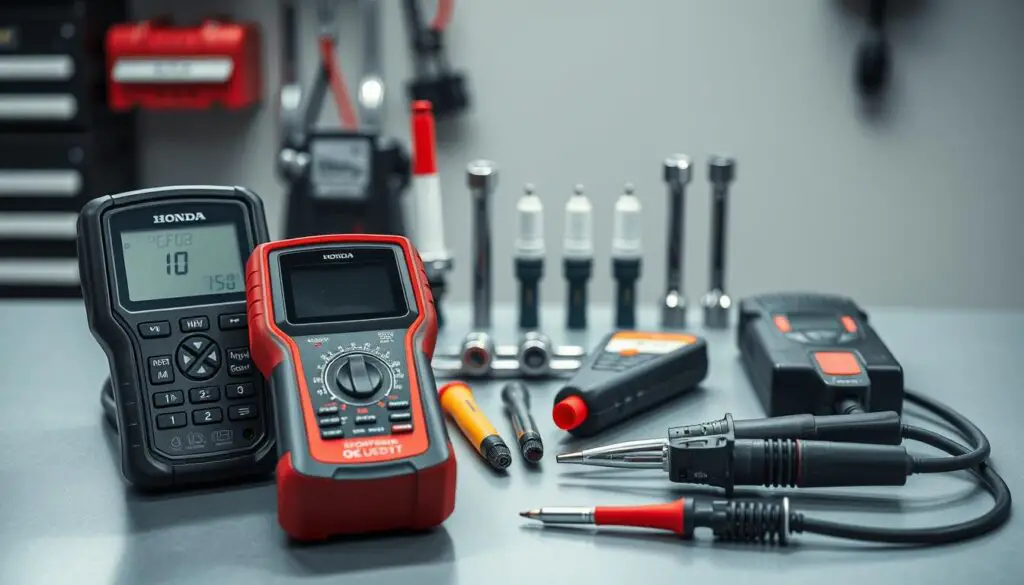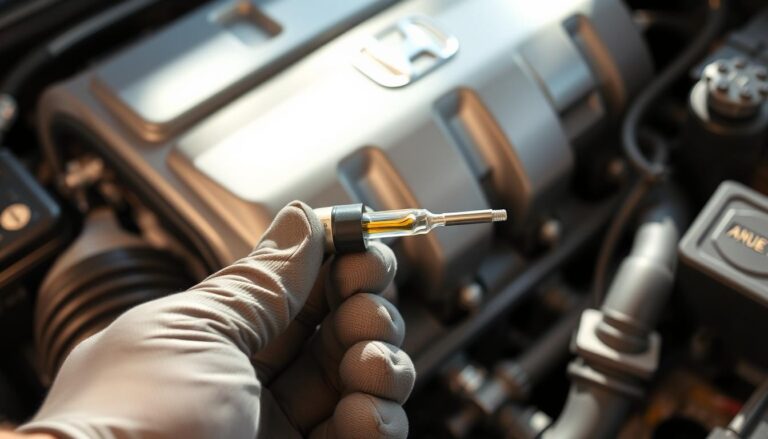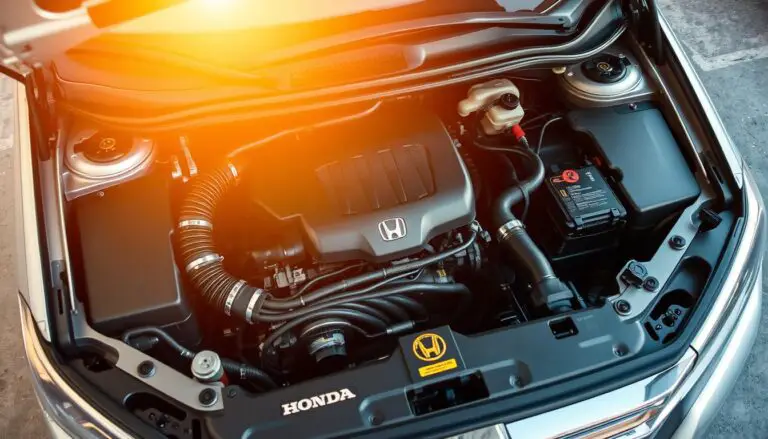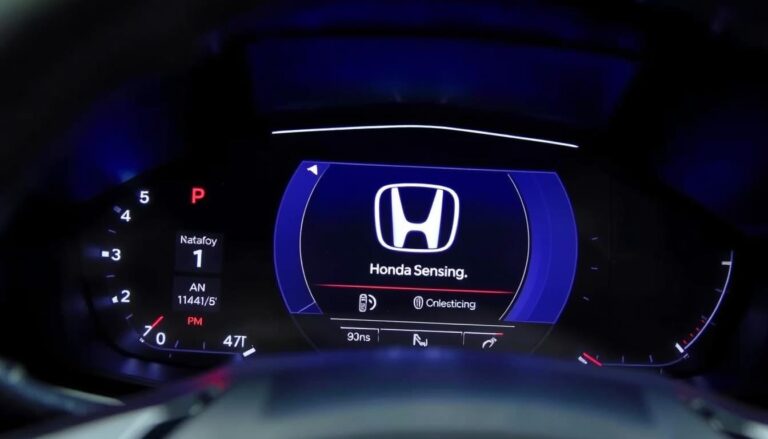Dealing with a vehicle that refuses to start can be frustrating, especially when it has power. If you’re experiencing Honda starting problems, you’re not alone. Many Honda owners face this issue, and it can stem from various causes.
Diagnosing the problem is the first step towards finding a solution. It’s essential to understand that a car not starting but having power indicates the issue might not be with the battery or the electrical system as a whole.
The key is to identify the root cause, whether it’s related to the ignition system, fuel system, or another component. By following a systematic approach, you can troubleshoot and potentially fix the issue.
Key Takeaways
- Understand the common causes of Honda not starting.
- Learn how to diagnose the issue systematically.
- Identify potential fixes based on the diagnosed problem.
- Discover when to seek professional help.
- Preventive measures to avoid future starting issues.
Understanding Why Your Honda Won’t Start But Has Power
Understanding the reasons behind a Honda’s failure to start, despite having power, is crucial for effective troubleshooting. When faced with this issue, it’s essential to remain calm and methodically diagnose the problem.
As diagnosing Honda starting issues can be complex, identifying the symptoms is the first step. Common symptoms include clicking sounds when turning the key, dim or flickering dashboard lights, or the engine cranking but not starting.
Common Symptoms and What They Mean
Recognizing the symptoms is vital. For instance, a clicking sound often indicates a problem with the starter motor or solenoid. As mechanic John Smith once said,
“A clicking sound when turning the key is often a sign of a faulty starter or a dead battery.”
Dim dashboard lights may suggest a weak battery or poor electrical connections.
Distinguishing Between No-Crank and No-Start Conditions
It’s crucial to differentiate between no-crank and no-start conditions. A no-crank condition means the engine doesn’t turn over when the key is turned, often due to battery or starter issues. In contrast, a no-start condition means the engine cranks but doesn’t start, potentially indicating problems with fuel delivery or ignition.
By understanding these differences, Honda owners can diagnose Honda starting issues more effectively and take the necessary steps to resolve the problem.
Essential Tools for Diagnosing Honda Starting Problems
Effective diagnosis of Honda starting issues begins with having the necessary tools and equipment. Diagnosing starting problems in your Honda requires a combination of basic and advanced tools to identify and fix the issue efficiently.
Basic Tools Every Honda Owner Should Have
Every Honda owner should have a basic toolkit that includes a multimeter, screwdrivers, and pliers. A multimeter is crucial for checking the battery voltage and electrical connections. Screwdrivers and pliers are handy for removing panels and accessing various components under the hood.

Advanced Diagnostic Equipment Worth Considering
For more complex issues, advanced diagnostic equipment such as an OBD-II scanner and a fuel pressure tester can be invaluable. An OBD-II scanner helps in reading trouble codes and monitoring engine performance. A fuel pressure tester is essential for diagnosing fuel system problems.
Step-by-Step Diagnostic Process
When your Honda fails to start despite having power, a step-by-step diagnostic process is essential. This systematic approach helps identify the root cause of the problem, ensuring that you don’t waste time or money on unnecessary repairs.
Checking the Battery and Electrical Connections
The first step in diagnosing a Honda that won’t start is to check the battery and electrical connections. Ensure the battery terminals are clean and securely connected. Corrosion or loose connections can prevent the car from starting.
- Inspect the battery terminals for signs of corrosion.
- Check the battery cables for damage or wear.
- Make sure the connections are tight and clean.
Testing the Starter System and Solenoid
If the battery and connections are in good condition, the next step is to test the starter system and solenoid. The starter motor is responsible for turning the engine over when you turn the key.
Key tests include:
- Checking the starter motor’s electrical circuit for any faults.
- Testing the solenoid to ensure it’s functioning correctly.
- Verifying that the starter motor is receiving the proper signal to operate.
Inspecting the Ignition Switch and Key Fob
A faulty ignition switch or key fob can also prevent your Honda from starting. Inspect these components for any signs of wear or damage.
- Check the ignition switch for any signs of wear or damage.
- Verify that the key fob is working correctly and has a good battery.
- Test the electrical circuit connected to the ignition switch.
By following this step-by-step diagnostic process, you can identify and potentially fix the issue preventing your Honda from starting.
Fixing Fuel System Issues When Honda Won’t Start But Has Power
If your Honda has power but won’t start, it’s crucial to investigate potential fuel system issues. The fuel system is responsible for delivering fuel to the engine, and any problems here can prevent your vehicle from starting.
Testing and Replacing the Fuel Pump
The fuel pump is a critical component of the fuel system, responsible for pressurizing the fuel lines. A failing fuel pump can cause your Honda not to start. To test it, listen for the humming noise it makes when you turn on the ignition. If it’s not making any noise, it may be faulty and need replacement.
Cleaning or Replacing Fuel Injectors
Fuel injectors spray fuel into the engine’s cylinders. Over time, they can become clogged with debris, preventing proper fuel flow. Cleaning or replacing fuel injectors can resolve starting issues. Using a fuel injector cleaning kit can help restore function, but severely clogged injectors may need to be replaced.
Addressing Fuel Pressure Problems
Fuel pressure is essential for the proper functioning of the fuel system. Low fuel pressure can prevent your Honda from starting. Check the fuel pressure using a fuel pressure gauge. If it’s below the manufacturer’s specification, identify and fix any leaks or blockages in the fuel system.
By addressing these potential fuel system issues, you can diagnose and potentially fix the problem of your Honda not starting despite having power. Regular maintenance of the fuel system can also help prevent such issues in the future.
Resolving Ignition and Engine Sensor Problems
Resolving ignition and engine sensor problems is crucial for Honda owners facing starting issues despite having power. These problems can be complex, requiring a systematic approach to diagnose and fix.
Spark Plug and Ignition Coil Troubleshooting
Faulty spark plugs or ignition coils can prevent a Honda from starting. Inspecting these components is a crucial step. Look for signs of wear or damage on spark plugs and check ignition coils for proper function. Replacing faulty spark plugs or coils can often resolve starting issues.
Key steps include: checking spark plug condition, testing ignition coil resistance, and ensuring proper spark plug gap.
Checking Critical Engine Sensors
Engine sensors, such as the crankshaft position sensor, play a vital role in engine operation. A faulty sensor can cause starting problems. Inspect these sensors for damage or malfunction. Cleaning or replacing them as needed can resolve issues.
- Crankshaft position sensor check
- Camshaft position sensor test
- Engine coolant temperature sensor inspection
Dealing with Honda-Specific Immobilizer Issues
Honda’s immobilizer system can sometimes cause starting issues if not properly synchronized with the key fob. Checking the immobilizer system and ensuring the key fob is functioning correctly is essential. This may involve reprogramming the key fob or replacing the immobilizer antenna.
It’s crucial to consult a professional if you’re unsure about handling immobilizer system repairs.
Fixing Your Honda: A Comprehensive Guide to Success
Understanding why your Honda won’t start but has power is crucial to resolving the issue. By following the step-by-step diagnostic process outlined in this Honda repair guide, you can identify and fix the problem efficiently.
Key to this process is using the right diagnostic tools and understanding the symptoms. Whether it’s a fuel system issue, an ignition problem, or an engine sensor fault, this guide has provided you with the knowledge to tackle Honda starting problems.
By applying the insights gained from this article, you’ll be well on your way to getting your Honda back on the road. For persistent issues, consider consulting a professional mechanic for further assistance, ensuring your Honda receives the best possible Honda repair guide.
FAQ
Why won’t my Honda start even though it has power?
There could be several reasons why your Honda won’t start despite having power. Common causes include a dead battery, faulty starter motor, ignition switch problems, or fuel system issues. It’s essential to follow a step-by-step diagnostic process to identify the root cause.
How do I check if my Honda’s battery is dead?
To check if your Honda’s battery is dead, use a multimeter to measure the voltage. A fully charged battery should read around 12.6 volts. If the voltage is significantly lower, it may indicate a dead battery. You can also try jump-starting your Honda to see if it starts.
What are the symptoms of a faulty starter motor in a Honda?
A faulty starter motor can cause a clicking or grinding noise when you turn the key, but the engine won’t turn over. In some cases, you might not hear any noise at all. If you suspect a faulty starter motor, it’s best to have it tested or replaced by a professional mechanic.
Can a bad ignition switch prevent my Honda from starting?
Yes, a bad ignition switch can prevent your Honda from starting. If the ignition switch is faulty, it may not send the proper signal to the starter motor, or it might not allow the engine to turn over. Inspecting the ignition switch and its connections can help diagnose the issue.
How do I test the fuel pump in my Honda?
To test the fuel pump, listen for the humming noise it makes when you turn the key to the “on” position. If you don’t hear the noise, it could indicate a faulty fuel pump. You can also use a fuel pressure gauge to check the fuel pressure. If it’s below the recommended specification, the fuel pump might need to be replaced.
What are the common signs of a faulty ignition coil in a Honda?
Common signs of a faulty ignition coil include misfires, rough idling, or a decrease in engine performance. If the ignition coil is faulty, it may not produce the necessary spark to ignite the fuel, preventing the engine from starting.
Can a Honda-specific immobilizer issue prevent the car from starting?
Yes, a Honda-specific immobilizer issue can prevent the car from starting. The immobilizer system is designed to prevent the engine from starting unless the correct key is used. If the immobilizer system is malfunctioning, it may not recognize the key, preventing the engine from starting.


